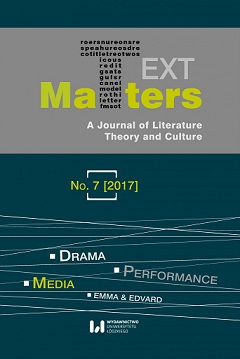Theatre as Contagion: Making Sense of Communication in Performative Arts
DOI:
https://doi.org/10.1515/texmat-2017-0016Keywords:
contagion as communicable disease, epidemic as metaphor, the tipping point, mimesis, participation in performative artsAbstract
Contagion is more than an epidemiological fact. The medical usage of the term is no more and no less metaphorical than in the entire history of explanations of how beliefs circulate in social interactions. The circulation of such communicable diseases and the circulation of ideas are both material and experiential. Diseases and ideas expose the power and danger of bodies in contact, as well as the fragility and tenacity of social bonds. In the case of the theatre, various tropes of contagion are to be found in both the fictional world on the stage (at least since Sophocles’ Oedipus Rex) and in many theories defining the rules of interaction between theatre audiences, fictitious characters and/or performers. In consequence, the historically changing concept of contagion has in many respects influenced how mimesis was conceived and understood. The main goal of my article is to demonstrate how the concept of contagion has changed over the last few decades and how it may influence our understanding of the idea of mimesis and participation in performative arts. This will be achieved in two steps. Firstly, I will compare the concept of contagion as the outbreak narrative that had influenced, among others, Antonin Artaud’s The Theater and the Plague with the more recent and dynamic concept of epidemic structured around the tipping point. Secondly, I will look for performative art forms with similar structure of audience responses, analyzing Mariano Pensotti’s project Sometimes I Think, I Can See You (2010), in order to demonstrate new forms of performativity and (re)presentation.
Downloads
References
Aristotle. Poetics. Trans. Ingram Bywater. Oxford: Clarendon, 1962. Print.
Google Scholar
Artaud, Antonin. The Theater and Its Double. Trans. Mary Caroline Richards. New York: Grove, 1958. Print.
Google Scholar
Augé, Marc. Non-Places. Introduction to an Anthropology of Supermodernity. Trans. John Howe. London: Verso, 1995. Print.
Google Scholar
Bishop, Claire. Artificial Hells. Participatory Art and Politics of Spectatorship. London: Verso, 2012. Print.
Google Scholar
Bourriaud, Nicolas. Postproduction. Culture as Screenplay: How Art Reprograms the World. New York: Lukas & Sternberg, 2002. Print.
Google Scholar
Fischer-Lichte, Erika. Performativität. Eine Einführung. Bielefeld: Transcript, 2012. Print.
Google Scholar
Fischer-Lichte, Erika. The Transformative Power of Performance: A New Aesthetics. Trans. Saskya Iris Jain. London: Routledge, 2008. Print.
Google Scholar
Foster, Susan Leigh. “Movement’s Contagion: The Kinesthetic Impact of Performance.” The Cambridge Companion to Performance Studies. Ed. Tracy C. Davis. Cambridge: Cambridge UP, 2008. 46–59. Print.
Google Scholar
Garner, Stanton B. “Artaud, Germ Theory, and the Theatre of Contagion.” Theatre Journal 1 (2006): 1–14. Print.
Google Scholar
Gladwell, Malcolm. The Tipping Point. How Little Things Can Make a Big Difference. Boston: Little, Brown and Company, 2000. Print.
Google Scholar
Girard, René. A Theatre of Envy: William Shakespeare. New York: Oxford UP, 1991. Print.
Google Scholar
Jopek, Joanna. “Praktyka porażki. Próby performatywności negatywnej.” Didaskalia 115–116 (2013): 43–49. Print.
Google Scholar
Latour, Bruno. The Pasteurization of France. Trans. Alan Sheridan and John Law. Cambridge: Harvard UP, 1993. Print.
Google Scholar
McNeil, William H. Plagues and People. New York: Doubleday, 1976. Print.
Google Scholar
Savarese, Nicola. “1931 Antonin Artaud Sees Balinese Theatre at the Paris Colonial Exposition.” Trans. Richard Fowler. The Drama Review 3 (2001): 51–77. Print.
Google Scholar
Wald, Priscilla. Contagious Cultures, Carriers, and the Outbreak Narrative. Durham: Duke UP, 2008. Print.
Google Scholar
Wehrle, Annika. Passagenräume. Grenzverläufe alltäglicher und performativer Praxis im Theater der Gegenwart. Bielefeld: Transcript, 2015. Print.
Google Scholar
Downloads
Published
How to Cite
Issue
Section
License
Copyright (c) 2017 A Journal of Literature, Theory and Culture

This work is licensed under a Creative Commons Attribution-NonCommercial-NoDerivatives 4.0 International License.













